
Armillaria is a genus of fungi that includes the A. mellea species known as honey fungi that live on trees and woody shrubs. It includes about 10 species formerly categorized summarily as A. mellea. Armillarias are long-lived and form the largest living fungi in the world. The largest known organism covers more than 3.4 square miles (8.8 km2) in Oregon's Malheur National Forest and is estimated to be 2,500 years old. Some species of Armillaria display bioluminescence, resulting in foxfire.

Edible mushrooms are the fleshy fruit bodies of several species of macrofungi. Edibility may be defined by criteria including the absence of poisonous effects on humans and desirable taste and aroma. Edible mushrooms are consumed for their nutritional and culinary value. Mushrooms, especially dried shiitake, are sources of umami flavor.
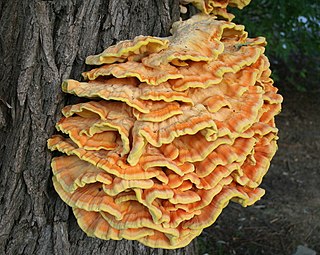
Laetiporus is a genus of edible mushrooms found throughout much of the world. Some species, especially Laetiporus sulphureus, are commonly known as sulphur shelf, chicken of the woods, the chicken mushroom, or the chicken fungus because it is often described as tasting like and having a texture similar to that of chicken meat.

Laetiporus sulphureus is a species of bracket fungus found in Europe and North America. Its common names are crab-of-the-woods, sulphur polypore, sulphur shelf, and chicken-of-the-woods. Its fruit bodies grow as striking golden-yellow shelf-like structures on tree trunks and branches. Old fruitbodies fade to pale beige or pale grey. The undersurface of the fruit body is made up of tubelike pores rather than gills.
Laetiporus baudonii is a species of polypore fungus in the family Fomitopsidaceae.
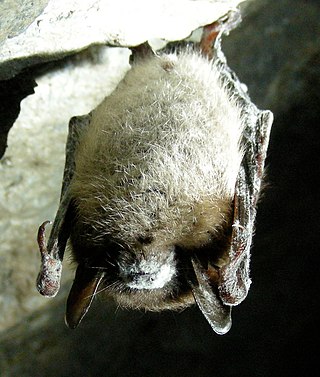
White-nose syndrome (WNS) is a fungal disease in North American bats which has resulted in the dramatic decrease of the bat population in the United States and Canada, reportedly killing millions as of 2018. The condition is named for a distinctive fungal growth around the muzzles and on the wings of hibernating bats. It was first identified from a February 2006 photo taken in a cave located in Schoharie County, New York. The syndrome has rapidly spread since then. In early 2018, it was identified in 33 U.S. states and seven Canadian provinces; plus the fungus, albeit sans syndrome, had been found in three additional states. Most cases are in the eastern half of both countries, but in March 2016, it was confirmed in a little brown bat in Washington state. In 2019, evidence of the fungus was detected in California for the first time, although no affected bats were found.

The Fomitopsidaceae are a family of fungi in the order Polyporales. Most species are parasitic on woody plants, and tend to cause brown rots. The name comes from Fomitopsis + -aceae.

Grifola frondosa is a polypore mushroom that grows at the base of trees, particularly old growth oaks or maples. It is typically found in late summer to early autumn. It is native to China, Europe, and North America.
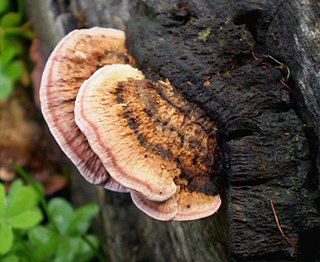
Rhodofomitopsis lilacinogilva is a species of bracket fungus in the family Fomitopsidaceae. Known primarily from Australia, it has also been recorded from Brazil and India. It is a white-rot fungus that grows on rotting eucalyptus wood. Its main identifying feature is the lilac colour of the pore surface on the underside of the fruit body.

Saproamanita nauseosa is a species of agaric fungus in the family Amanitaceae. First described by English mycologist Elsie Maud Wakefield in 1918 as a species of Lepiota, it was named for its nauseating odor. The type specimen was found growing on soil in the Nepenthes greenhouse at Kew Gardens. Derek Reid transferred the species to Amanita in 1966, and then in 2016 the separate genus Saproamanita was created by Redhead et al. for saprophytic Amanitas and it was transferred to this new genus.
Armillaria altimontana is a species of agaric fungus in the family Physalacriaceae. The species, found in the Pacific Northwest region of North America, was officially described as new to science in 2012. It was previously known as North American biological species (NABS) X. It grows in high-elevation mesic habitats in dry coniferous forests. This species has been found on hardwoods and conifers and is associated most commonly with fir-dominated forest types in southern British Columbia, Washington, Oregon, Idaho and northern California.

Hallomenus axillaris is a species of fungus beetle in the family Tetratomidae. It was described by German entomologist Johann Karl Wilhelm Illiger in 1807. It is found in Europe. In the Moscow region, it has been recorded growing in the fruitbodies of the fungi Hapalopilus rutilans, Laetiporus sulphureus, Polyporus squamosus, Postia fragilis, Pycnoporellus fulgens, Tyromyces chioneus, and Fomes fomentarius.
Laetiporus zonatus is a species of polypore fungus in the family Fomitopsidaceae. It is found in southwestern China, where it grows on oak. The species was described as new to science in 2014 by Baokai Cui and Jie Song. The specific epithet zonatus refers to the concentric rings on the upper surface of the white to cream-colored fruit body. The fungus produces ellipsoid to pear-shaped (pyriform) or drop-shaped basidiospores that measure 5.8–7.2 by 4.3–5.5 μm. Molecular analysis of internal transcribed spacer DNA sequences indicate that L. zonatus is a unique lineage in the genus Laetiporus.
Laetiporus ailaoshanensis is a species of polypore fungus in the family Fomitopsidaceae. It is found in southwestern China, where it grows on Lithocarpus. The species was described as new to science in 2014 by Baokai Cui and Jie Song. Its fruit body has an orange-yellow to reddish-orange cap surface, with cream to buff pores on the cap underside. The fungus produces ovoid to ellipsoid basidiospores that measure 5.0–6.2 by 4.0–5.0 μm. Molecular analysis of internal transcribed spacer DNA sequences indicate that L. ailaoshanensis is a unique lineage in the genus Laetiporus.

Laetiporus conifericola is a species of polypore fungus in the family Fomitopsidaceae. It is found in western North America ranging from California to Alaska, where it grows as a plant pathogen on conifer trees, particularly fir, spruce, and hemlock. Fruit bodies of the fungus comprise overlapping pore-bearing plates, measuring collectively up to 60 cm (24 in) across, and up to 4 cm (2 in) thick. Their color ranges from bright orange to salmon orange on the upper surface of the cap and stipe, with a yellow pore surface on the cap underside. Spores are egg-shaped, smooth, hyaline (translucent), and measure 6.5–8.0 by 4.0–5.0 μm. The species has a pleasant odour when fresh.
Laetiporus cremeiporus is a species of polypore fungus in the family Fomitopsidaceae. It is found in cooler temperate areas of China and Japan, where it grows on logs and stumps of hardwood trees, especially oak. The fruit body of the fungus comprises large masses of overlapping reddish-orange caps with a cream-colored pore surface on the underside.

Laetiporus gilbertsonii is a species of polypore fungus in the family Fomitopsidaceae. It is found in western North America. It was one of three new Laetiporus species published in 2001, which were distinguished genetically from the common Laetiporus sulphureus; the others were L. conifericola and L. huroniensis. The type collection, made in San Francisco's Golden Gate Park in 1997, was found fruiting on a eucalyptus tree. It has also been collected in Oregon and Washington. The fungus is named in honor of mycologist Robert Lee Gilbertson. L. gilbertsonii is edible, although some people have reported experiencing upset stomach after consuming it. Laetiporus conifericola is very similar in appearance, but is readily distinguished by its growth on conifers.
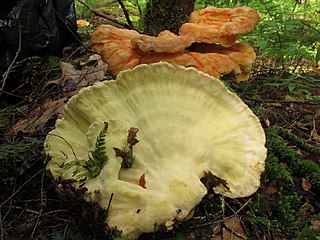
Laetiporus huroniensis is a species of polypore fungus in the family Fomitopsidaceae. It is found in the Great Lakes region of eastern North America, where it fruits on large logs in old growth conifer forests. The type collection, made in Ottawa National Forest in September 1999, was found fruiting on Tsuga canadensis. It was one of three new Laetiporus species published in 2001, which were distinguished genetically from the widespread Laetiporus sulphureus; the others were L. conifericola and L. gilbertsonii.
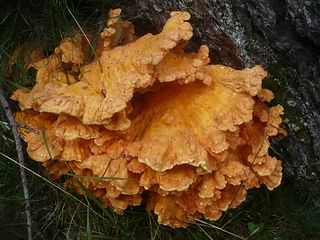
Laetiporus montanus is a species of polypore fungus in the family Fomitopsidaceae. It is found in mountainous areas of central Europe and in China, where it grows on conifers.

Laetiporus portentosus is a species of polypore fungus in the family Fomitopsidaceae. It is found in South America, Australia, and New Zealand. It has been used traditionally as a tinder and to carry fire by Australian Aboriginals, and by New Zealand Māori people. The Māori have also used it as a "wound protector, to soften and ease a difficult labor."














